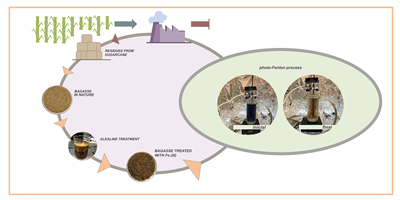Photo-Fenton Process Using Fe(III) Ions from Modified Sugarcane Bagasse for Reactive Black 5 Dye (RB5) Removal

- Advanced oxidative process,
- Photo-Fenton,
- Modified sugarcane bagasse,
- Textile dye removal
Copyright (c) 2021 Orbital: The Electronic Journal of Chemistry

This work is licensed under a Creative Commons Attribution-NonCommercial-NoDerivatives 4.0 International License.
Abstract
Brazil is one of the largest generators the sugarcane bagasse, this kind of biomass has already shown efficiency related to its in natura adsorption potential (when physically or chemically activated), it can also be used to remove contaminants from water in methods such as advanced oxidative processes. In this study, chemical modifications were carried out in sugarcane bagasse to enable its application in photo-Fenton processes for the degradation of reactive black 5 dye. The materials were chemically activated through immersion in Fe(III) solution for different periods of time: 3, 6, 9, 12, 24, 48 and 96 h; and were characterized by Fourier transform infrared spectroscopy (FTIR), X-ray diffraction (XRD), zeta potential analysis, internal surface area and leached metal quantification. The results showed the cellulose structure, which is predominant in the sugarcane bagasse it was not considerably modified after activation with FeCl3 and evidence of the presence of Fe(III) ions on the surface of the studied material. The degradation efficiency (after 5 min and using 11.5 mg L-1 hydrogen peroxide) for the activated materials was respectively: 55.85%, 49.44%, 71.22%, 92.87%, 88.16% and 98.02%, considering the decrease of the band related to the chromophore group (598 nm).
